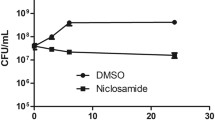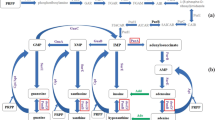Abstract
The therapeutic potential of urease inhibitionof Helicobacter pylori has been studied by examining theeffect of the potent urease inhibitor, fluorofamide(N-(diaminophosphinyl)-4-fluorobenzenamide), on urease activity and bacterial survival invivo and in vitro. In culture, acid protection in H.pylori was shown to be due to changes in the pH of themedium brought about by the release of ammonia. Both the acid protection and the ammoniarelease were completely blocked by fluorofamide at lowdoses (ED50 = ~100 nM). However, fluorofamidewas unstable under acidic conditions (T1/25.7 min at pH 2). Despite this, fluorofamide was the best availablecompound to test in vivo. In ferrets naturally infectedwith H. mustelae, a single dose (50 mg/kg, per os ) offluorofamide completely inhibited bacterial urease. In repeat dosing studies, fluorofamide(50 mg/kg per os, three times a day) was compared withthe Helicobacter triple therapy regime (amoxycillin,metronidazole, and bismuth subcitrate). Fluorofamide failed to eradicate the H. mustelae infection,compared to 80% eradication with triple therapy.However, histological samples showed a profoundreduction in bacterial numbers following fluorofamidetreatment. A combination of fluorofamide and amoxycillinwas dosed to ferrets (seven days of treatment with 50mg/kg fluorofamide plus 10 mg/kg amoxycillin per ostwice a day); however, this failed to eradicate the infection, despite there being a reduction inbacterial numbers in 3/5 ferrets after 21 days afterdosing stopped. It was concluded that urease inhibitors(either alone or in combination with antibiotics) are unlikely to have therapeutic potential forHelicobacter pylori infections. This is probablybecause, in vivo, some bacteria (perhaps dormant forms)are not entirely dependent upon urease for survival. However, given the acid instability offluorofamide, the possibility that more stable ureaseinhibitors might have therapeutic potential, cannot beexcluded.
Similar content being viewed by others
REFERENCES
Cover TL, Blazer MJ: Helicobacter pyloriand gastroduodenal ulcer disease. Annu Rev Med 43:135–145, 1992
Lee A, Fox J, Hazell S: Minireview. Pathogenicity of H. pylori: A perspective. Infect Immun 61(5):1601–1610, 1993
Dixon MF: H. pyloriand peptic ulceration: Histopathological aspects. J Gastroenterol Hepatol 6:125–130, 1991
Miseiwicz JJ: Helicobacter pylori: Past present and future. Scand J Gastroenterol 27(S194):25–29, 1992
Sipponen P, Kosuneutu VJ, Riihela M, Seppela K: Infection and chronic gastritis in gastric cancer. J Clin Pathol 45:319–323, 1992
McNulty CAM, Dent JC, Wise R: Susceptibility of Campylobacter pylorito twenty one antimicrobial agents. Eur J Clin Microbiol Infedct Dis 7:567–469, 1988
Malfertheiner P: Compliance, adverse effects and antibiotic resistance in Helicobacter pyloritreatment. Scand J Gastroenterol 196:34–37, 1993
Mobely HLT, Hausinger RP: Microbial ureases: Significance, regulation and molecular characterisation. Microbiol Rev 53:85–108, 1989
Austin JW, Doig P, Stewart M, Trust T: Macromolecular structure and aggregation states of Helicobacter pyloriurease. J Bacteriol 173:5663–5667, 1991
Dunn BE, Campbell GP, Perez-Perez GI, Blaser MJ: Purification and characterisation of urease from Helicobacter pylori. J biol Chem 265:9464–9469, 1990
Marshall BJ, Barret LJ, Prakash C, McCallum RW, Guerrant RL: Urea protects Helicobacter(Campylobacter) pylorifrom the bactericidal effect of acid. Gastroenterology 99:697–702, 1990
Bode G, Malfertheiner P, Lehnhardt G, Ditschuneit H: Virulence factors of Helicobacter pylori— ultrastructural feature s. In Helicobacter pylori, Gastritis and Peptic Ulcer. Berlin, Springer-Verlag, p 63–73, 1990
Smoot DT, Mobley HLT, Chippendale GW, Lweison JF, Re sau JH: Helicobacter pyloriurease activity is toxic to human gastric epithelial cells. Infect Immun 58:1992-1994, 1990
Brady CE, Hadfield TL, Hyatt JR, and Utts SJ: Acid secretion and serum gastrin levels in individuals with Campylobacter pylori. Gastroenterology 94(4):923–927, 1988
Costas M, Owen RJ, Morgan DD, Goodwin CS: Loss of urease activity in Helicobacter pylori. Lett Appl Microbiol 14:260–264, 1991
Eaton KA, Brooks CL, Morgan DR, Krakowka S: Essential role of urease in pathogenesis of gastritis induced Helicobacter pyloriin gnotobiotic piglets. Infect. Immun 59:2470–2475, 1991
Sciortino CV JR: An immunofluorescent stain for Helicobacter pylori. Hybridoma 12:333–342, 1993
Weatherburn MW: Phenol-hypochlorite reaction for determination of ammonia. Anal Biochem 39:971–975, 1967
Warthin AS, Starry AC: A more rapid and improved method of demonstrating spirochaetes in tissues. Am J Syph Gonnorhea Vener Dis 4:97–101, 1920
Correa P: Chronic gastritis. A clinico-pathological classification. Am J Gastroenterol 83:504–509, 1988
Phillips K, Munster DJ, Allardyce RA, Bagshaw PF: Antibacterial action of the urease inhibitor acetohydroxamic acid on Helicobacer pylori. J Clin Pathol 46(4):372–373, 1993
Otto G, Fox JG, Wu PY, Taylor NS: Eradication of Helicobacter pylorifrom the ferret stomach: An animal mode l of Helicobacter(Campylobacter) pylorichemotherapy. Antimicrob Agents Chemother 34( 6):1232–1236, 1990
Kobashi K, Takebe S, Numata A: Specific inhbition of urease by N-acylphosphoric triamides. J Biochem 98:1681–1688, 1985
Millner OE Jr, Andersen JA, Appler ME, Benjamin CE, Edwards JG, Humphrey DT, Shearer EM: Fluorofamide: A potent inhibitor of bacterial urease with potential clinical utility in the treatment of infection induced urinary stones. J Urol 127:346–350, 1982
IM WB, Blakeman DP, Davis JP: Irreversible interaction of the rat gastric (H+-K+ )-ATPase in vivoby omeprazole. Biochem Biophys Res Commun 126:78–82, 1985
Newell DG: Virulence factors of Helicobacter pylori. Scand J Gastroenterol 26(suppl 187):31–38, 1991
Anon: Flurofamide. Drugs Future 7(10):734–735, 1982
Rights and permissions
About this article
Cite this article
Pope, A.J., Toseland, N., Rushant, B. et al. Effect of Potent Urease Inhibitor, Fluorofamide, on Helicobacter sp. in Vivo and in Vitro. Dig Dis Sci 43, 109–119 (1998). https://doi.org/10.1023/A:1018884322973
Issue Date:
DOI: https://doi.org/10.1023/A:1018884322973




